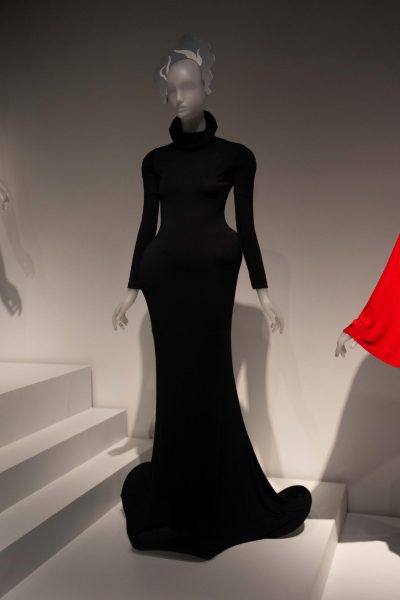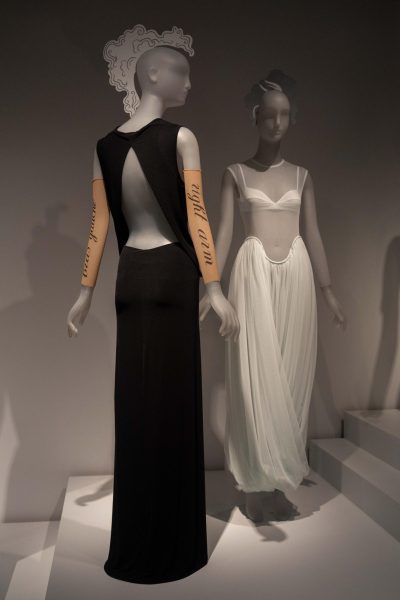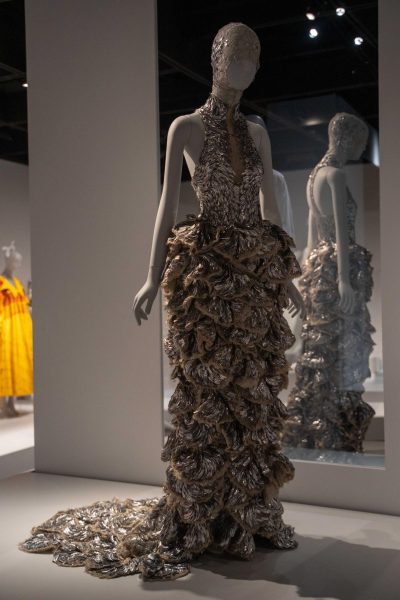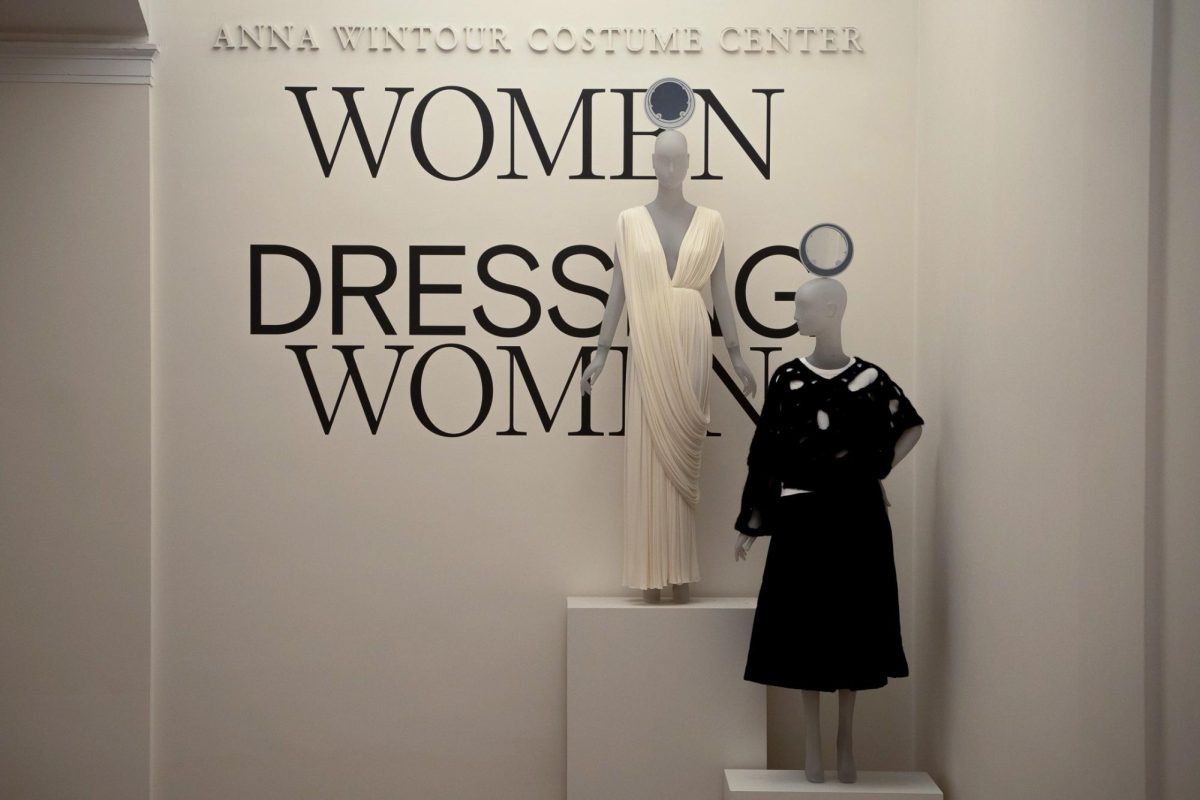In an exhibition space in a lower level of the Metropolitan Museum of Art lives a fashion oasis entirely devoted to the genius of women. When viewers first walk into “Women Dressing Women,” they are met with dazzling evening gowns by iconic fashion designers, displayed in a dark room with lights only illuminating the garments. A moody playlist ripples throughout the space, adding to the atmosphere established by the decor.
“Women Dressing Women” takes a comprehensive look at the history of fashion from a feminist perspective. The show, curated by Mellissa Huber, an associate curator at the Met’s Costume Institute, and Karen Van Godtsenhoven, highlights over 70 female designers that have contributed to The Costume Institute’s collection, a department of the museum entirely devoted to fashion.
The Met’s director and CEO Max Hollein stated in a press release that “Women Dressing Women will also continue the Museum’s dedication to amplifying historically underappreciated voices while celebrating the work of those who have become household names.”
The large exhibition is divided into four subsections: anonymity, visibility, agency and absence/omission.
The anonymity section is devoted to the forgotten women in fashion from the early 1900s. In Europe, women were not always allowed to make garments — this was a “slowly earned privilege,” according to the exhibition label. Over time, European women, particularly in France, fought to expand their rights to work in the industry. Meanwhile, in the United States, garment work was disregarded as a domestic task whose importance went unrecognized by the public. In both cases, it was uncommon for clothing to be linked to specific designers and dressmakers. Even when designers were recognized, nobody else in the garment-making process was, excluding the recognition of those like millworkers, seamstresses and more.
This section of the exhibition doesn’t include specific works of clothing, instead displaying a photographic slideshow of women working in ateliers and garment factories from the early 20th century. The section gives a face to those who have been left anonymous in the history of fashion.
The visibility segment highlights the first wave of prosperous female designers in France, particularly couturiers. During the time period between world wars, designing became a field dominated by women, and dressmaking houses began to rely on designers as the face of their brand, overcoming the prior restraints of anonymity. Though these women still had limited freedoms, this period of history was a step in the right direction for women in fashion, and this section of the exhibition does these groundbreaking women justice.
A 1938 evening dress from the House of Paquin, designed by Ana de Pombo, showcases the importance of allowing women to design womenswear. The ivory silk organza dress has a beautiful sweetheart neckline trimmed with black monkey fur. The fur looks like long feathers and is also used on the skirt of the dress, below a belt that highlights the natural curvature of the female figure. This dress highlights the thoughtfulness women bring to the design of womenswear, as the shapes and styles that appeal to many are honored and created.
The agency section of the exhibition is the largest, and rightfully so. While “Visibility” highlighted an incredible part of fashion history, the womenswear featured was very limited in its designs and audience. Women were still forced into only wearing so-called “traditional” silhouettes due to societal expectations, and these couture pieces were inaccessible to women from lower social classes.
Conversely, “Agency” explores women’s ready-to-wear clothing in the United States, which is a field dominated by women. The section focuses on the ’60s-’70s, when women designers began to integrate social and artistic messages into their pieces, and the ’80s-’90s, when designers began to expand their reach of clients, go against societal expectations and use the body as a canvas for creativity — showing how female designers maximized the use of their creative agency.
“Agency” is split into seven subsections that each highlight nuanced trends prevalent during this time period, and includes mannequins that vary in body shape and size. For example, within “Reclaiming the Body” there is a black Georgina Godley evening gown with a turtleneck and extremely accentuated hips, a floor-length black Ann Demeulemeester dress with beige arm sleeves that read “gauche bras” on the left arm and “right arm” in script and other designs with similar themes.


Additionally, the subsection “Empowerment Through Practice” represents designers that integrate values of sustainability and artistic partnership, with a Marine Serre hooded floor-length dress perfectly exemplifying these themes. The collaged, bright, floral-printed dress is made out of popcorn-esque polyester-elastane fabrics, with cutouts at the waistline that reveal a crescent moon pattern. For the collection that the dress is a part of, Serre used both deadstock and recycled fabric.

Finally, the absence/omission section, which is placed in the center of the exhibition space, showcases garments from many different periods of history. As stated in the title, this section highlights aspects of fashion that are typically left out of “museum collections and the canon of fashion,” according to the wall text, and confronts barriers that women designers have faced, including legal issues, racial inequality and more.
This section includes a stunning Alexander McQueen silk-organza dress made from glass and silver and designed by Sarah Burton. The halter-topped dress has layers upon layers of silver and glass swirls over nude fabric, leading into a train. Burton went into designing at McQueen as an unknown name and yet blew people away with her genius, overcoming the preconceived notion that nobody could successfully design for the brand after founding designer Alexander McQueen’s suicide.
It is worth noting that the exhibition was not the most accessible experience. The Met is almost always very crowded, and there is no cap on how many people can attend the exhibition at once. Because the gallery space had many additional walls built in the room to set up the garments correctly, walking was difficult. Moreover, the space is generally difficult to navigate, with labels not clearly outlining which section of garments is being referred to.
Overall, “Women Dressing Women” underscores the importance of female designers in the canon of fashion history, uplifting women who have been overlooked and highlights the work of women who have forever changed the art form.
“Women Dressing Women” is on view at the Met until March 10. To kick off Women’s History Month and celebrate the end of the exhibition, the Met will be holding a panel entitled Empowerment Through Practice in Fashion on March 1.
Contact Alexa Donovan at [email protected].

























































































































































